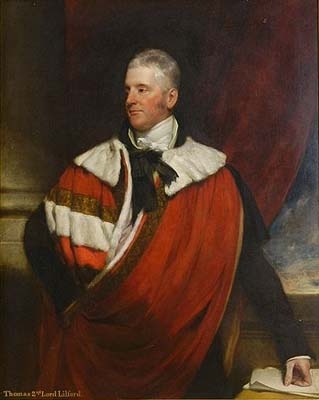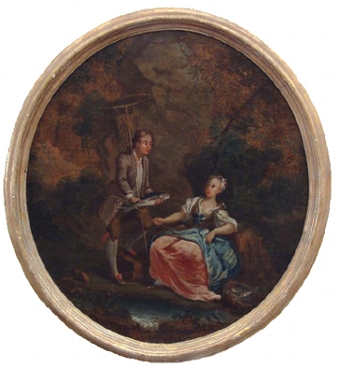featured item
portrait of robinetta
- View other items in:
- antiques interior design modern and vintage
- other interior design
artware ltd
Enquire about this antique
Artware Ltd has 565 antiques for sale.
click here to see them all
This painting relates to Reynolds paintings; "Robinetta" painted circa 1786 , 749 x 622 mm in the Tate collection Londonand and "Lesbia" the child was often painted by Reynolds. In this portrait the young girl is looking down andtherfore she is not engaging the viewer, the drappery also differs from the portrait in the Tate collection.
Reynolds was born in Plympton, Devon, on 16 July 1723. As one of eleven children, and the son of the village school-master, Reynolds was restricted to a formal education provided by his father. He exhibited a natural curiosity and, as a boy, came under the influence of Zachariah Mudge, whose Platonistic philosophy stayed with him all his life. Showing an early interest in art, Reynolds was apprenticed in 1740 to the fashionable portrait painter Thomas Hudson, with whom he remained until 1743. From 1749 to 1752, he spent over two years in Italy, where he studied the Old Masters and acquired a taste for the "Grand Style". Unfortunately, whilst in Rome, Reynolds suffered a severe cold which left him partially deaf and, as a result, he began to carry a small ear trumpet with which he is often pictured. From 1753 until the end of his life he lived in London, his talents gaining recognition soon after his arrival in France. Reynolds worked long hours in his studio, rarely taking a holiday. He was both gregarious and keenly intellectual, with a great number of friends from London''s intelligentsia, numbered amongst whom were Dr Samuel Johnson, Oliver Goldsmith, Edmund Burke, Giuseppe Baretti, Henry Thrale, David Garrick and fellow artist Angelica Kauffmann. Because of his popularity as a portrait painter, Reynolds enjoyed constant interaction with the wealthy and famous men and women of the day, and it was he who first brought together the famous figures of "The" Club. By 1761 Reynolds could command a fee of 80 Guineas for a full-length portrait (Mr Fane); in 1764 he was paid 100 Guineas for a portrait of Lord Burghersh. With his rival Thomas Gainsborough, Reynolds was the dominant English portraitist of ''the Age of Johnson''. It is said that in his long life he painted as many as three thousand portraits. Although not principally known for his landscapes, Reynolds did paint in this genre. He had an excellent vantage from his house on Richmond Hill, and painted the view in about 1780. In 1789 he lost the sight of his left eye, which finally forced him into retirement. In 1791 James Boswell dedicated his Life of Samuel Johnson to Reynolds. Reynolds died on 23 February 1792 in his house in Leicester Fields in London. He was buried at St. Paul''s Cathedral.
Professionally, Reynolds'' career never peaked. He was one of the earliest members of the Royal Society of Arts, helped found the Society of Artists, and, with Gainsborough, established the Royal Academy of Arts as a spin-off organisation. In 1768 he was made the RA''s first President, a position he held until his death. As a lecturer, Reynolds'' Discourses on Art (delivered between 1769 and 1790) are remembered for their sensitivity and perception. In one of these lectures he was of the opinion that "invention, strictly speaking, is little more than a new combination of those images which have been previously gathered and deposited in the memory." Reynolds and the Royal Academy have historically received a mixed reception. Critics include many of the Pre-Raphaelites, and William Blake, the latter having published his vitriolic Annotations to Sir Joshua Reynolds'' Discourses in 1808. To the contrary, both J. M. W. Turner and James Northcote were fervent acolytes: Turner requested he be laid to rest at Reynolds'' side, and Northcote (who lived for four years as Reynolds'' pupil) wrote to his family "I know him thoroughly, and all his faults, I am sure, and yet almost worship him." The word worship is second cast; originally Northcote had written adore.
In appearance Reynolds was not at all striking. Slight of frame, he was just about 5''6" with dark brown curls, a florid complexion and features which James Boswell thought were "rather too largely and strongly limned." He had a broad face, a cleft chin, and the bridge of his nose was slightly dented; his skin was scarred by smallpox, and his upper lip disfigured as a result of falling from a horse as a young man. Nonetheless he was not considered ugly, and Edmond Malone asserted that "his appearance at first sight impressed the spectator with the idea of a well-born and well-bred English gentleman." Renowned for his placidity, Reynolds often claimed that he "hated nobody". Never quite losing his Devonshire accent, he was not only an amiable and original conversationalist but a friendly and generous host, so that Fanny Burney recorded in her diary that he had "a suavity of disposition that set everybody at their ease in his society", and William Makepeace Thackeray believed "of all the polite men of that age, Joshua Reynolds was the finest gentleman." Dr. Johnson commented on the inoffensiveness of his nature; Edmund Burke noted his "strong turn for humor". Thomas Bernard, who later became Bishop of Killaloe, wrote in his verses on Reynolds:
It is to this luke-warm temperament that Frederick W. Hilles, Bodman Professor of English Literature at Yale attributes the fact Reynolds never married. In the editorial notes of his compendium Portraits by Sir Joshua Reynolds, Hilles theorizes that "as a corollary one might say that he [Reynolds] was somewhat lacking in a capacity for love", and cites Boswell''s notary papers: "He said the reason he would never marry was that every woman whom he liked had grown indifferent to him, and he had been glad he did not marry her." Reynolds'' own sister, Frances, who lived with him as housekeeper, took her own negative opinion further still, thinking him "a gloomy tyrant". Strangely, it was this very presence of family that compensated Reynolds for the absence of a wife; He wrote on one occasion to his friend Bennet Langton, that both his sister and niece were away from home "so that I am quite a bachelor." Biographer Ian McIntyre discusses the possibility of Reynolds having enjoyed sexual rendezvous with certain clients, such as Nelly O''Brien (or "My Lady O''Brien", as he playfully dubbed her) and Kitty Fisher, who visited his house for more sittings than were strictly necessary. Claims to this end are, however, purely speculative.
Antiques.co.uk Ref: KVU35GPX
- Materials:
- Oil on Canvas
- Width (cm):
- 76.20 x 63.50 cm 30.00 x 25.00 ins
Artware Ltd
Artware Fine Art specialises in fine antique, decorative and historical portraits and topographical pictures . We cover a period from the 17th and 18th centuries through to the 19th & 20th Centuries. We have over 150 portraits in stock, which can be viewed on our web site, each historical portrait has well researched biographical information both on the sitter and the artist.
Contact details
18 La gare
51 Surrey row
London
Greater London
SE1 0BZ
UNITED KINGDOM
T: 0207 921 97904
E: greg@artwarefineart.com
W: www.artwarefineart.com














